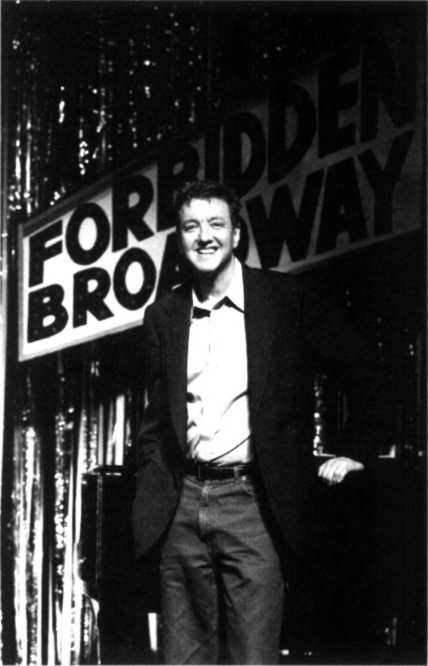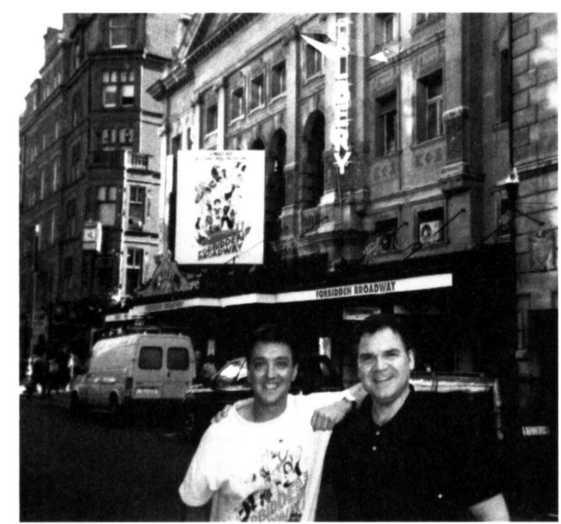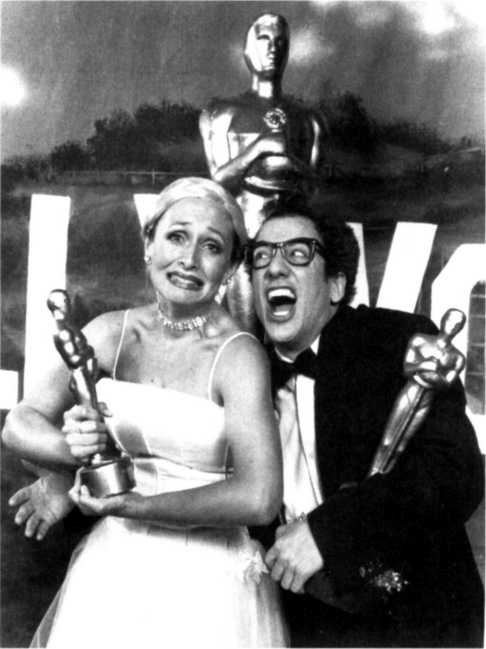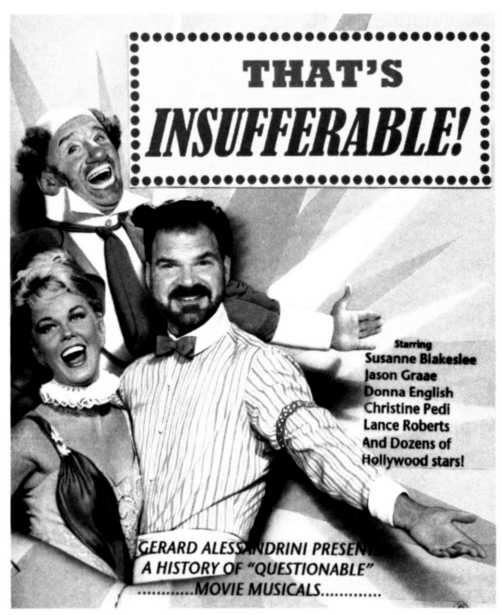Forbidden Broadway: Behind the Mylar Curtain (133 page)
Read Forbidden Broadway: Behind the Mylar Curtain Online
Authors: Gerard Alessandrini,Michael Portantiere

I had been part of the cast of the Boston production,
which was then in its fifth smash year at the Terrace Room
Theatre. Now, Boston had a theatre-loving audience for
sure; it was still one of the big Broadway tryout towns.
But that didn't necessarily mean there were enough of
those people to keep FB running in a 250-seat house for
five years. University students were also coming. So were
the whale-watching, leaf-loving tourists who stayed in the
mammoth Boston Park Plaza, where the Terrace Room
Theatre was located. And they all adored the show.

Forbidden Broadway producer John Freedson.
When I was onstage, I could see which numbers in
particular made people laugh so hard that they fall out of
their chairs. So when a bold producer from Kansas City
named Mark Edelman called in the summer of 1989 and
asked if we felt the show could play a long run there, I
told Gerard that I thought it would work if we picked the
numbers that always went over in Boston: Evita, Annie,
Merman and Martin, "Screamgirls," Liza, and a few others.
Those numbers would play anywhere-we hoped.
I went to Kansas City to direct the production, convinced that we would have to cast ringers from NewYork to
make the show as brilliant as it should be. To my surprise and delight, I found that Kansas City had talent to spare; Lori Blalock, Deanna Hurst,
Don Richard, K. C. Helmeid, and Susan Kingwill gave the New York and Boston companies a run for their money.
The show was an enormous hit in Kansas City, playing for more than a year. Night
after night, audiences laughed at Patti's musical berating of Barbra, Lauren Bacall's
mannishness, Jennifer Holliday's histrionics, the misery of Les Miz, Annie's advanced
age, and Liza's one note. It was all there
in the writing. Gerard had always told
me that he wrote each joke with his
mother in Needham, Massachusetts, in
mind. Would she get everything? Would
his aunt Erminie and cousin Madeline?
If a joke passed the Alessandrini test,
it could be certified to hit the laugh-ometer for any audience, anywhere.

John Freedson and Gerard Alessandrini in London.
Hot off our success in K.C.-where
we played return engagements in 1990,
1993, 1996, and 2003-we decided to really test the limits of the show's appeal.
Big League Theatricals approached us
and asked if we would like to put together a non-Equity tour to play onenight stands and split weeks in towns
like Sheboygan, Wisconsin; Klamath
Falls, Idaho; Seguin, Texas; and Pella,
Iowa. I was engaged to direct the tour, and I was concerned about whether non-Equity
performers would have the chops to handle the material. Well, one of the people who
attended that non-union call was a young woman named Christine Pedi, who told
us that she didn't know if she could do impressions and then blew us away with her
channeling of Charming, Merman, and Liza.
Gerard and I fought over Christine; he wanted to put her immediately into the
New York show, but ultimately he relented and let me have her for the tour. We both
realized that if anyone could sell the humor of Forbidden Broadway to an audience
in Sheboygan, it was Christine. By the way, that non-Equity call also brought us Lori
Hammel, who went on to star in Forbidden Broadway Cleans Up Its Act in 1998 and
still does an occasional road date of the show more than twenty years later.
One of the great things about touring Forbidden Broadway is that it has a unit set
consisting entirely of a Mylar curtain and a decorative portal to scale down the prosceniums of some of the huge vaudeville-era houses we played: the 2,700-seat Proctors
Theatre in Schenectady, New York; The Corn Palace (that's not a joke!) in Mitchell, South Dakota; the mammoth Garden State Arts Center in Holmdel, New Jersey, where
Judy Garland once fell asleep onstage; and so on. Twenty-two feet of playing width,
sixteen feet of height, a grand piano, Alvin Colt's fabulous costumes, and a cast full of
outsize personalities were all we needed to make magic.
Over the years, the show has wowed audiences in small towns all over the country.
We often get letters from presenters in which they express surprise that their audiences
had such a great time at the show, but it's no longer a surprise to us. As we've learned
over the years, the jokes in Forbidden Broadway are so well set up that even if you
don't understand the specific references to Tommy Tune and Twiggy or whomever,
you laugh at the brilliant delivery, the wit of the lyrics, the pratfalls of the staging.
You might be surprised at which numbers have played well in Peoria. Sometimes
it's a spoof of a really popular show, like Jersey Boys. Sarah Brightman's "Time I Said
Goodbye" always slays 'em. But what about Aspects of Love? Who in Middle America
ever heard of that Andrew Lloyd Webber flop? Yet, for many years, that number was a
staple of every regional and touring production of the show.Three half-naked people
standing behind a sheet and singing "I Sleep with Everyone" is just funny.
In Japan, where we have done four productions of the show (with supertitles), the
audiences laughed so uncontrollably every time "Julie Andrews" modulated down
another half step in "I Couldn't Hit the Note" that we wondered whether the supertitles
actually said, "Laugh here so as not to offend the American guests." In fact, the people
just got the musical in-joke. In Singapore, the cast was treated like rock stars, swarmed
by fans for autographs outside the theatre. In London, after a sold-out run at the tiny
Jermyn Street Theatre, we transferred for the summer to the West End's Albery. At this
writing, a new production is running at the Menier Chocolate Factory.
A special thrill for me is presenting Forbidden Broadway in concert with symphony
orchestras around the world. The show incorporates some of the greatest songs of
Richard Rodgers, Jule Styne, Frederick Loewe, and Stephen Sondheim; hearing that
music performed by massed strings, trumpets, and timpani is pure heaven. I sit in
the back and cry.
Yet after all this, when presenters from all over the country converge on New York
in January to scope out shows and when they see Forbidden Broadway, many of them
still say to me: "I had a great time at your show, but my audience in Akron will never
get it." After I finish banging my head against a wall, I calmly tell them that we've had
twenty years of success in small towns throughout the U.S., and I explain the secret
of Forbidden Broadway: The show somehow makes everyone feel like a showbiz insider. They nod, and some of them believe me and book the show for their upcoming
season. They're never sorry that they did.
-John Freedson
With almost any showbiz success, thoughts of a sequel come up at some point. Even
while creating various editions of Forbidden Broadway, I was haunted by the idea of
related Forbidden shows. I had always wanted to do Forbidden Opera, because I had
studied opera and I'm a big fan of the genre, but the commercial potential for that
seemed low. So I turned to the movies for inspiration. I love Hollywood films, both
classic and contemporary, and I thought Forbidden
Hollywood might be a fun and exciting project.

Whitney Allen and Mark David Kaplan as Gwyneth
Paltrow and Roberto Benigni in Forbidden Hollywood.
On the one hand, this spin-off would be easier to
create than Forbidden Broadway because so many
more films exist as compared to stage shows, and
also because movies have far greater recognition
among the masses. The downside was the topical
nature of the medium; one year, everybody could
be talking about a movie or a star, and the next year,
they could be almost forgotten. So I decided that if
we were going to tackle the movies, we had to cover
the history as well as the contemporary. In a sense,
I was inspired by That's Entertainment, the terrific
(as Liza would put it) compilation of sequences from
great MGM musicals. The chance to rewrite the lyrics of songs from classic films like Singin'in the Rain
was enticing.
John Freedson and Harriet Yellin headed the team
that mounted the first production of Forbidden Hollywood in Los Angeles in 1995. We tried the show
out in San Diego and experimented with dozens
of numbers. I drove the talented cast crazy as we worked on "That's the Bible!"-a spoof of The Ten Commandments and Ben Hur.
The number was long, rather leaden, and more than a little sacrilegious. To the great
relief of the cast, I finally dropped it. But other numbers that we worked and worked,
such as Bette Midler singing "Who's Gay in Hollywood?" and a Woody Allen sketch,
eventually paid off.
While the show was a great success in L.A.,
it didn't fare nearly as well in New York and
Chicago, where presumably people don't care
as much about film and its history. This spinoff also had the handicap of not spoofing a
medium through its own medium, as Forbidden Broadway does. In fact, late at night after performances of Forbidden Hollywood in
L.A., the cast and I had a raucous time making a video that spoofed movies. I christened
it That's Insufferable!The actors played stars
like Liza and Dietrich introducing clips from
questionable movie musicals.

The cover of That's Insufferable, a mockumentary by
Gerard and the Forbidden Hollywood cast.
